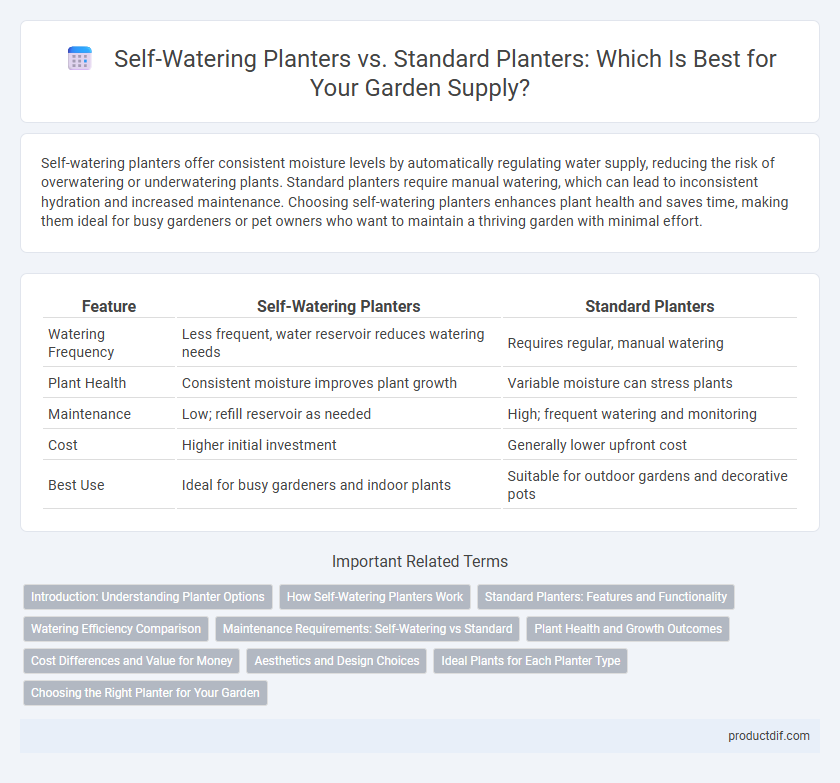Self-watering planters offer consistent moisture levels by automatically regulating water supply, reducing the risk of overwatering or underwatering plants. Standard planters require manual watering, which can lead to inconsistent hydration and increased maintenance. Choosing self-watering planters enhances plant health and saves time, making them ideal for busy gardeners or pet owners who want to maintain a thriving garden with minimal effort.
Table of Comparison
| Feature | Self-Watering Planters | Standard Planters |
|---|---|---|
| Watering Frequency | Less frequent, water reservoir reduces watering needs | Requires regular, manual watering |
| Plant Health | Consistent moisture improves plant growth | Variable moisture can stress plants |
| Maintenance | Low; refill reservoir as needed | High; frequent watering and monitoring |
| Cost | Higher initial investment | Generally lower upfront cost |
| Best Use | Ideal for busy gardeners and indoor plants | Suitable for outdoor gardens and decorative pots |
Introduction: Understanding Planter Options
Self-watering planters feature integrated reservoirs that provide consistent moisture directly to plant roots, reducing the frequency of watering and minimizing the risk of over or underwatering. Standard planters require manual watering and careful monitoring to maintain soil moisture, making them more suited for gardeners who prefer hands-on plant care. Choosing between self-watering and standard planters depends on factors like plant type, maintenance preference, and watering consistency needs.
How Self-Watering Planters Work
Self-watering planters utilize a built-in reservoir that continuously supplies water to plants through capillary action, ensuring consistent moisture levels in the soil. This system minimizes the risk of overwatering or underwatering by allowing plants to absorb water as needed, promoting healthier root development. Standard planters require regular manual watering, which can lead to inconsistent soil moisture and potential plant stress.
Standard Planters: Features and Functionality
Standard planters offer versatile design options and are typically made from materials like terracotta, ceramic, or plastic, providing durability and aesthetic appeal. These planters require regular manual watering, allowing gardeners full control over moisture levels, which is ideal for plants sensitive to overwatering. Their straightforward functionality and affordability make standard planters a popular choice for indoor and outdoor gardening enthusiasts.
Watering Efficiency Comparison
Self-watering planters enhance watering efficiency by reducing water waste through a built-in reservoir that delivers consistent moisture directly to plant roots, minimizing evaporation and runoff. Standard planters rely on surface watering, which often leads to uneven moisture distribution and frequent watering needs, increasing water consumption. Studies show self-watering planters can reduce water usage by up to 30% compared to traditional containers, making them ideal for conserving water in garden supply.
Maintenance Requirements: Self-Watering vs Standard
Self-watering planters significantly reduce maintenance by providing a consistent water supply through an internal reservoir, minimizing the frequency of watering and preventing over or underwatering. Standard planters demand more frequent manual watering and close monitoring to avoid soil drying out or waterlogging, which can stress plants. The self-watering system supports healthier root growth and lowers the risk of plant stress due to irregular moisture levels, making it ideal for gardeners seeking low-maintenance solutions.
Plant Health and Growth Outcomes
Self-watering planters maintain consistent soil moisture, reducing stress on roots and promoting healthier, faster plant growth compared to standard planters that require frequent manual watering. These planters also minimize the risk of overwatering and root rot, improving overall plant health. Standard planters, while more traditional, often lead to uneven moisture levels that can hinder optimal nutrient absorption and stunt growth.
Cost Differences and Value for Money
Self-watering planters typically have a higher upfront cost compared to standard planters due to their built-in reservoir and irrigation technology, which reduces the need for frequent watering. Standard planters are less expensive initially but may require additional resources such as frequent watering and maintenance, potentially increasing long-term costs. Considering value for money, self-watering planters offer better water efficiency and plant health, making them a cost-effective option for gardeners seeking convenience and sustainability.
Aesthetics and Design Choices
Self-watering planters offer sleek, modern designs with integrated water reservoirs that blend functionality with contemporary aesthetics, perfect for minimalist and urban gardens. Standard planters provide diverse styles ranging from classic terracotta to ornate ceramic, allowing greater customization in color, texture, and shape to match traditional or eclectic garden themes. Choosing between the two depends on whether visual appeal prioritizes clean, streamlined practicality or decorative versatility in garden design.
Ideal Plants for Each Planter Type
Self-watering planters are ideal for moisture-loving plants such as ferns, herbs like basil and mint, and tropical houseplants that require consistent hydration. Standard planters suit drought-tolerant species like succulents, cacti, and Mediterranean herbs such as rosemary and thyme, which thrive with less frequent watering. Choosing the right planter type based on plant water needs enhances growth and reduces maintenance.
Choosing the Right Planter for Your Garden
Self-watering planters feature a reservoir that maintains consistent moisture, reducing the frequency of watering and promoting healthier plant growth. Standard planters rely on manual watering, which offers flexibility but requires more attentive care to avoid under or overwatering. Selecting the right planter depends on your garden's watering needs, plant types, and maintenance preferences to ensure optimal growth and convenience.
Self-watering planters vs Standard planters Infographic

 productdif.com
productdif.com